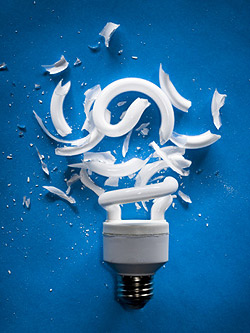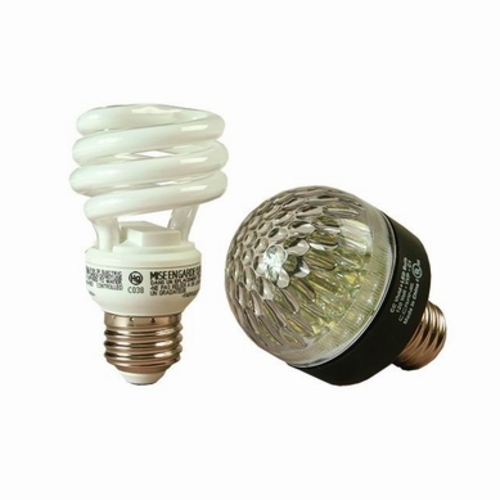
At a wedding last weekend, I heard the following story third-hand, attributed to a local landscape designer.
There was a large group of relatives of this gentleman who had lived their lives in Dorchester, Mass. — in the Boston metro area — and had never gone anywhere else. Ever.
Well, a major reunion was happening in Delaware, and some of the Dorchester clan decided to go. They filled three cars and set out in a caravan. As the story goes, they made it as far as northern New Jersey without incident. At some point they had to leave the Turnpike and head off into the local roads — after dark. Now, parts of New Jersey and Delaware are very rural, and the caravan soon found itself on some rural county roads with no traffic lights, no streetlights, no lighted billboards, and — gasp — no traffic. “What has happened here,” they thought? “Something must be terribly wrong.” All three cars turned around and went back to Dorchester.
CFLs: A signpost of environmentalism
We all need signposts and transitions when leaving the beaten path. For a lot of people, compact fluorescent lightbulbs, or CFLs, have been one of the chief signs of energy efficiency and environmentalism for the last decade-and-a-half.
You have probably heard statistics like these: a single CFL can save more than $40 in electricity costs over its lifetime. A CFL uses about 75% less energy than a standard incandescent bulb and lasts up to 10 times longer. A CFL produces about 75% less heat, so it’s safer to operate and can cut energy costs associated with home cooling.
Safe to operate—but when they break down?
Hold it — safer to operate maybe, but breakdowns, as Fukushima has reminded us, happen. Are CFLs safe when broken? The average CFL contains around 5 mg of mercury, about 100 times less than an old-fashioned oral thermometer. Over the last few years there have been media reports highlighting apparently scary costs of proper household cleanup of broken CFLs. Four years ago, reports started circulating about a woman in Maine who got a $2,000 hazardous material cleanup estimate, for example.
Mercury in fish and other foods can lead to long-term accumulation of mercury in the body, but mercury vapor, like that contained in bulbs, is more of a problem. Ingested mercury is not well absorbed by the body, while inhaled mercury enters the bloodstream readily.
EPA’s 10 steps to CFL cleanup
In response, the Environmental Protection Agency (EPA) issued guidelines earlier this year about how to deal with a broken compact fluorescent lamp (CFL) without calling in the bomb squad.
According to EPA, here are the key steps to safely cleaning up a shattered CFL:
1) Remove all people and pets from the room where the bulb broke.
2) Ventilate the room by opening a window for a few minutes.
3) Shut off central air conditioning or heating, for several hours if possible.
4) Avoid vacuuming in a mercury-contaminated area.
5) Pick up fragments with cardboard rather than a vacuum cleaner.
6) Pick up remnants with tape.
7) Seal all debris inside a glass jar (since plastic bags will not prevent mercury vapor from escaping).
8) Store sealed glass jar outside the home.
9) Open windows and turn off central climate control the next few times you vacuum the room.
10) Check with local waste disposal authorities about how to dispose of all CFLs, whether broken or not.
Where I live, some retailers will take used CFLs at no charge, and the local transfer station will take broken CFLs any day of the week.
How great is the danger?
How much of a danger are CFLs? A document accompanying the new release on the EPA website suggests that the minuscule amount of vaporized mercury from a single broken bulb is within the safe range for adults. Studies have measured the level of vapor shortly after a CFL breakage to be between 8 and 20 micrograms per cubic meter, and levels decline rapidly within a few minutes. To give some context, 100 micrograms per cubic meter is considered a safe level for long-term occupational exposure.
However, the scientists conclude that there is not enough data to make a similar evaluation regarding children — especially since children’s behaviors are different from adults’ — and a reliable risk assessment regarding children and broken CFLs is not currently available.
In the absence of evidence that short-term, low-level exposure is safe for all households, the EPA’s guidelines help consumers minimize that exposure until more is known.
I am doubtful that most people will follow these guidelines. Who has the time or attention for steps like this? Who can turn off the heat and open a window for hours at a time during the winter? Do homeowners or renters know how to turn off the air?
Fortunately, I think it’s safe to say that the risk is fairly minimal. But it’s worth being careful and following EPA’s steps as best as you can. It’s too bad, though, when a major signpost to environmentalism contains hidden dangers behind it.
How important are windows, really?
Dear Energy Solutions, A couple months ago you said that windows weren’t really important. Then you’ve told us about nothing but windows for three weeks. What gives? – Tom, Halifax, VT.
Tom, I’m sorry if your eyes were “glazing” over. My earlier advice was that window retrofits can be relatively expensive, with a long “payback” time. There are a lot of reasons to buy new windows, though, and not just for new construction. It’s hard to calculate a payback on comfort, and occupants can feel much warmer in winter when a drafty, single-pane window is replaced. But if you have older, inefficient windows and replacing them seems like a stretch for your budget, look for future columns where I’ll discuss which window attachment options — plastic films, window quilts, etc. — are effective.
Thanks to Paula Melton at BuildingGreen for contributing to this column with research on CFL cleanup.
Tristan Roberts is Editorial Director at BuildingGreen, Inc., in Brattleboro, Vermont, which publishes information on green building solutions. You can learn more at www.BuildingGreen.com.
Weekly Newsletter
Get building science and energy efficiency advice, plus special offers, in your inbox.













3 Comments
CFLs Just Plain S*ck
They've been around 20 years, and they still have many shortcomings.
LED bulbs have only just become acceptable, go out and get you some, and let CFLs become an awkward memory, like Members Only jackets.
"This energy saving LED bulb is mercury-free, cool running, and lights up instantly. Bulb lasts up to 20,000 hours and resists shock and vibration. Bulb is NOT dimmable. Bulb has a standard base. 1.6-watts. UL listed."
http://www.bedbathandbeyond.com/product.asp?sku=16918130&utm_source=google&utm_medium=organic&utm_campaign=shopping
A dimmable LED bulb at this price will be available very soon.
No good $12.99 LED yet...
Kevin, that bulb is 1.6W... probably equivalent to about a 25W incandescent at best.
I'm all for LED technology, but encouraging people to drop $13 on a bulb which will likely only disappoint them probably won't help. Early CFLs did plenty of damage to their reputation, I'm afraid the same may happen with LEDs...
Dim Bulb
Brighter ones are becoming more available. Check the bulb aisle whenever you go to Lowe's and Sam's Club. Their offerings are always changing. Yesterday I got the last two 40W equivalent LED bulbs on closeout for $13 each.
And there are fun ways to multiply their brightness: http://greenbuildingindenver.blogspot.com/2009/11/led-lighting-update.html#comments
Log in or create an account to post a comment.
Sign up Log in